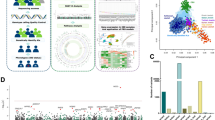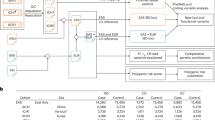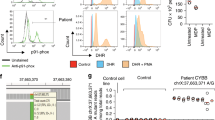Abstract
Inflammatory bowel disease (IBD) is a common inflammatory disorder with complex etiology that involves both genetic and environmental triggers, including but not limited to defects in bacterial clearance, defective mucosal barrier and persistent dysregulation of the immune response to commensal intestinal bacteria. IBD is characterized by two distinct phenotypes: Crohn's disease (CD) and ulcerative colitis (UC). Previously reported GWA studies have identified genetic variation accounting for a small portion of the overall genetic susceptibility to CD and an even smaller contribution to UC pathogenesis. We hypothesized that stratification of IBD by age of onset might identify additional genes associated with IBD. To that end, we carried out a GWA analysis in a cohort of 1,011 individuals with pediatric-onset IBD and 4,250 matched controls. We identified and replicated significantly associated, previously unreported loci on chromosomes 20q13 (rs2315008[T] and rs4809330[A]; P = 6.30 × 10−8 and 6.95 × 10−8, respectively; odds ratio (OR) = 0.74 for both) and 21q22 (rs2836878[A]; P = 6.01 × 10−8; OR = 0.73), located close to the TNFRSF6B and PSMG1 genes, respectively.
This is a preview of subscription content, access via your institution
Access options
Subscribe to this journal
Receive 12 print issues and online access
$209.00 per year
only $17.42 per issue
Buy this article
- Purchase on Springer Link
- Instant access to full article PDF
Prices may be subject to local taxes which are calculated during checkout


Similar content being viewed by others
References
Podolsky, D.K. Inflammatory bowel disease. N. Engl. J. Med. 347, 417–429 (2002).
Mathew, C.G. & Lewis, C.M. Genetics of inflammatory bowel disease: progress and prospects. Hum. Mol. Genet. 13 (Spec. No. 1), R161–168 (2004).
Duerr, R.H. et al. A genome-wide association study identifies IL23R as an inflammatory bowel disease gene. Science 314, 1461–1463 (2006).
Baldassano, R.N. et al. Association of variants of the interleukin-23 receptor gene with susceptibility to pediatric Crohn's disease. Clin. Gastroenterol. Hepatol. 5, 972–976 (2007).
Hampe, J. et al. A genome-wide association scan of nonsynonymous SNPs identifies a susceptibility variant for Crohn disease in ATG16L1. Nat. Genet. 39, 207–211 (2007).
Rioux, J.D. et al. Genome-wide association study identifies new susceptibility loci for Crohn disease and implicates autophagy in disease pathogenesis. Nat. Genet. 39, 596–604 (2007).
Wellcome Trust Case Control Consortium. Genome-wide association study of 14,000 cases of seven common diseases and 3,000 shared controls. Nature 447, 661–678 (2007).
Libioulle, C. et al. Novel Crohn disease locus identified by genome-wide association maps to a gene desert on 5p13.1 and modulates expression of PTGER4. PLoS Genet. 3, e58 (2007).
Parkes, M. et al. Sequence variants in the autophagy gene IRGM and multiple other replicating loci contribute to Crohn's disease susceptibility. Nat. Genet. 39, 830–832 (2007).
Baldassano, R.N. et al. Association of the T300A non-synonymous variant of the ATG16L1 gene with susceptibility to paediatric Crohn's disease. Gut 56, 1171–1173 (2007).
Moffatt, M.F. et al. Genetic variants regulating ORMDL3 expression contribute to the risk of childhood asthma. Nature 448, 470–473 (2007).
Meinzer, U. et al. Ileal involvement is age dependent in pediatric Crohn's disease. Inflamm. Bowel Dis. 11, 639–644 (2005).
Levine, A. et al. Pediatric onset Crohn's colitis is characterized by genotype-dependent age-related susceptibility. Inflamm. Bowel Dis. 13, 1509–1515 (2007).
Dideberg, V. et al. An insertion-deletion polymorphism in the interferon regulatory Factor 5 (IRF5) gene confers risk of inflammatory bowel diseases. Hum. Mol. Genet. 16, 3008–3016 (2007).
van Heel, D.A. et al. Inflammatory bowel disease is associated with a TNF polymorphism that affects an interaction between the OCT1 and NF(-kappa)B transcription factors. Hum. Mol. Genet. 11, 1281–1289 (2002).
D'Haens, G.R. et al. Early lesions of recurrent Crohn's disease caused by infusion of intestinal contents in excluded ileum. Gastroenterology 114, 262–267 (1998).
D'Haens, G. et al. Endoscopic and histological healing with infliximab anti-tumor necrosis factor antibodies in Crohn's disease: a European multicenter trial. Gastroenterology 116, 1029–1034 (1999).
Ina, K. et al. Resistance of Crohn's disease T cells to multiple apoptotic signals is associated with a Bcl-2/Bax mucosal imbalance. J. Immunol. 163, 1081–1090 (1999).
Satsangi, J. et al. Contribution of genes of the major histocompatibility complex to susceptibility and disease phenotype in inflammatory bowel disease. Lancet 347, 1212–1217 (1996).
Fayad, R., Brand, M.I., Stone, D., Keshavarzian, A. & Qiao, L. Apoptosis resistance in ulcerative colitis: high expression of decoy receptors by lamina propria T cells. Eur. J. Immunol. 36, 2215–2222 (2006).
Kim, S., Fotiadu, A. & Kotoula, V. Increased expression of soluble decoy receptor 3 in acutely inflamed intestinal epithelia. Clin. Immunol. 115, 286–294 (2005).
Chang, Y.C. et al. Modulation of macrophage differentiation and activation by decoy receptor 3. J. Leukoc. Biol. 75, 486–494 (2004).
Wortinger, M.A. et al. Fas ligand-induced murine pulmonary inflammation is reduced by a stable decoy receptor 3 analogue. Immunology 110, 225–233 (2003).
Chang, Y.C. et al. Epigenetic control of MHC class II expression in tumor-associated macrophages by decoy receptor 3. Blood 111, 5054–5063 (2008).
Hsu, T.L. et al. Modulation of dendritic cell differentiation and maturation by decoy receptor 3. J. Immunol. 168, 4846–4853 (2002).
Silverberg, M.S. et al. Toward an integrated clinical, molecular and serological classification of inflammatory bowel disease: report of a Working Party of the 2005 Montreal World Congress of Gastroenterology. Can. J. Gastroenterol. 19 (Suppl. A), 5–36 (2005).
Falush, D., Stephens, M. & Pritchard, J.K. Inference of population structure using multilocus genotype data: linked loci and correlated allele frequencies. Genetics 164, 1567–1587 (2003).
Hakonarson, H. et al. A genome-wide association study identifies KIAA0350 as a type 1 diabetes gene. Nature 448, 591–594 (2007).
Acknowledgements
We would like to thank all participating subjects and families. We thank M. Garris, K. Thomas, A. Albano, E. Dabaghyan, K. Fain, W. Glaberson, K. Harden, A. Hill, C. Johnson-Honesty, L. McCleery, K. Lake, R. Bezold, A. Ryan, A. Thomas, A. Latiano and R. Skraban for their expert assistance with DNA processing, genotyping, RNA preparation, DCR3 ELISA, data collection or study management. We thank A. Rutherford and J. Nebel for study coordination. We also thank S. Kristinsson, L. Arni Hermannsson and A. Krisbjörnsson of Raförninn ehf for their extensive software design and informatics contribution. This research was financially supported by US National Institutes of Health grant (K23RR016111), Crohn's & Colitis Foundation of America (CCFA), The Koss foundation, the NIH General Clinical Research Center of the Medical College of Wisconsin (S.K.), NIH grant R01 DK058259, the CCFA (L.D.), the Primary Children's Medical Center Foundation, K23DK069513, M01-RR00064, C06-RR11234 from the National Center for Research Resources (S.L.G.), the Edmunds Fund, the Heineman Foundation, the IBD Family Research Council (R.B.), a Research Development Award from the Cotswold Foundation (H.H. and S.F.A.G.) and a CTSA award, UL1-RR024134-03 (H.H.). Colon microarray experiments were performed and analyzed in the Microarray and Bioinformatics Cores of the NIH-supported Cincinnati Children's Hospital Research Foundation Digestive Health Center (1P30DK078392-01). H. Xu of the Bioinformatics Core assisted with analysis of the microarray experiments. All genotyping and other aspects of the study were funded by an Institute Development Award (H.H., S.F.A.G.) from the Children's Hospital of Philadelphia. We thank the members of the International HapMap and Wellcome Trust Case Control Consortiums for publicly providing valuable data, which were crucial for part of our analyses.
Author information
Authors and Affiliations
Contributions
S.K., R.N.B. and H.H. designed the study and H.H. supervised the genotyping data analysis and interpretation. L.A.D. designed and supervised the microarray and ELISA experiments, data analysis and interpretation. J.P.B., P.M.A.S. and S.F.A.G. conducted the statistical analyses. S.K., R.N.B., S.L.G., S.C., G.T., V.A. and L.A.D recruited the individuals with IBD and performed all phenotyping. C.E.K. and E.C.F. directed the genotyping in a team consisting of J.T.G., J.L.S., R.M.S. and F.G.O. J.P.B., M.I., K.A., J.T.G., A.W.E. and E.S. provided bioinformatics support. The remaining authors coordinated the studies. S.K., R.N.B., S.L.G., L.A.D., S.F.A.G. and H.H. wrote the manuscript.
Corresponding author
Supplementary information
Supplementary Text and Figures
Supplementary Methods, Supplementary Tables 1–3, Supplementary Figures 1 and 2 (PDF 366 kb)
Rights and permissions
About this article
Cite this article
Kugathasan, S., Baldassano, R., Bradfield, J. et al. Loci on 20q13 and 21q22 are associated with pediatric-onset inflammatory bowel disease. Nat Genet 40, 1211–1215 (2008). https://doi.org/10.1038/ng.203
Received:
Accepted:
Published:
Issue Date:
DOI: https://doi.org/10.1038/ng.203
This article is cited by
-
Personalized Medicine for IBD Patients
BioNanoScience (2023)
-
ZBTB46 defines and regulates ILC3s that protect the intestine
Nature (2022)
-
Mutation spectrum of NOD2 reveals recessive inheritance as a main driver of Early Onset Crohn’s Disease
Scientific Reports (2021)
-
Somatic mosaicism and common genetic variation contribute to the risk of very-early-onset inflammatory bowel disease
Nature Communications (2020)
-
AIEC infection triggers modification of gut microbiota composition in genetically predisposed mice, contributing to intestinal inflammation
Scientific Reports (2018)



